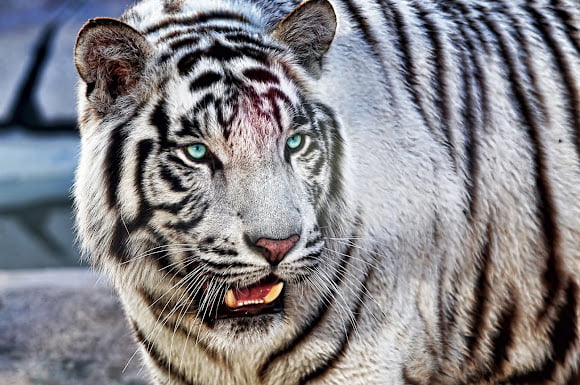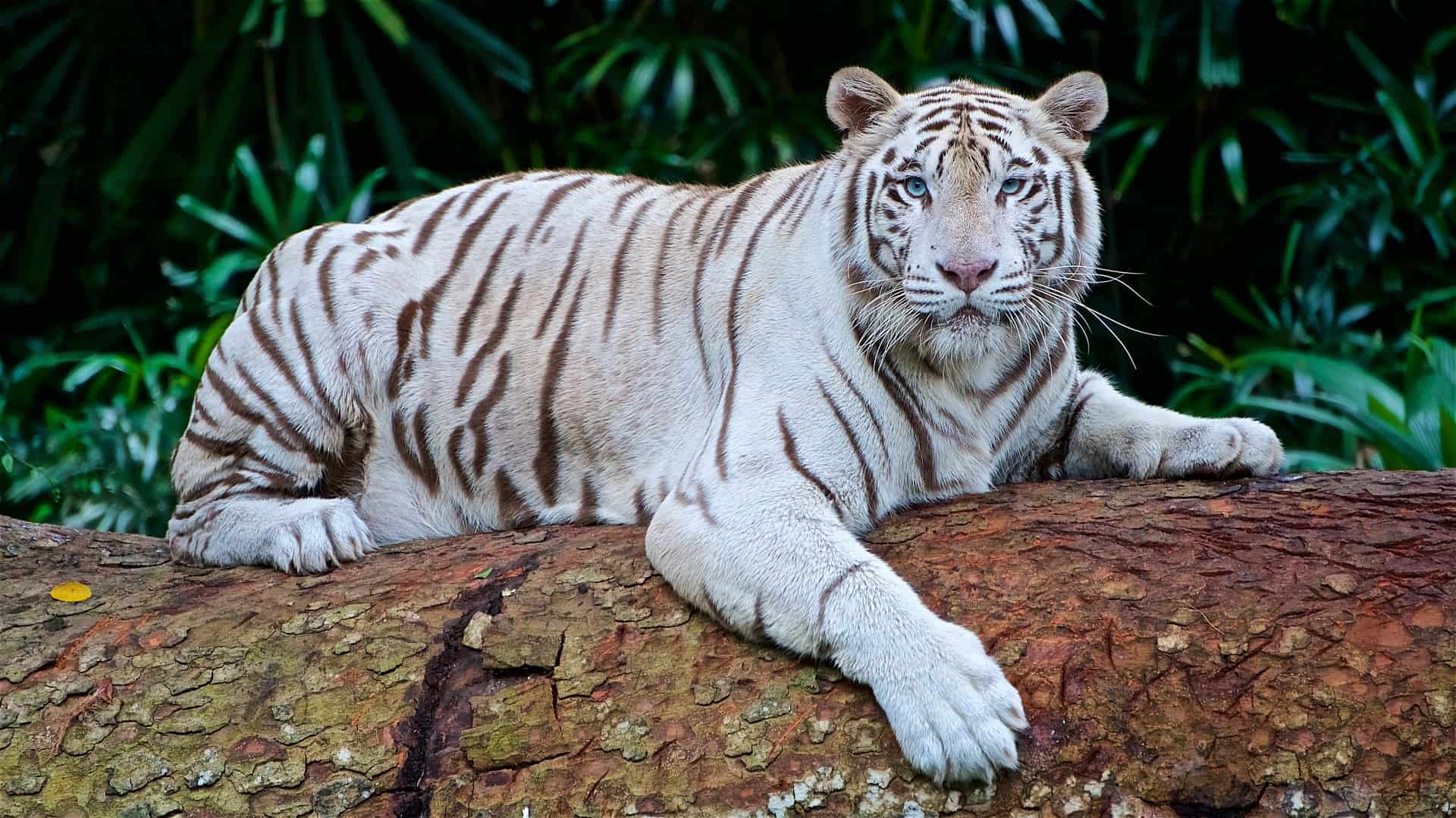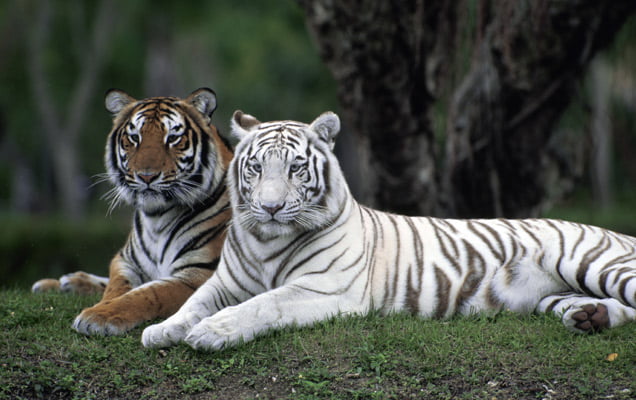20 Interesting Facts About White Siberian Tiger
Share

Looking for interesting facts about white Siberian tigers to teach your kids? The white tigers are peculiar animals that can easily grab your kid’s attention. We are celebrating International Tigers Day on July 29th.
You can let your kid celebrate the next International Tigers Day by knowing its true importance and by teaching him some amazing facts about white tigers. Even you might have some curious doubts about them. Are white Siberian tigers a different species? How did they get such a special coat that is different from other tigers?
We will discuss everything about white tigers in this article by listing out some amazing facts that can enlighten you and your children alike.
White Siberian Tiger
White Siberian tigers or white tigers belong to the Panthera tigris tigris family. They are Bangel tigers with white coated fur with dark stripes and blue eyes. It is this appearance that makes them an interesting category of big cats. Being just another color variant of the Bengal Tigers, you might often wonder why they are termed the White Siberian Tiger.
Well, it is just wrong! White tigers, being referred to as Siberian tigers, is one of the most common confusion among people across the globe. They have no direct connection with the Siberian tigers.
The reason why white tigers get such a distinct look from their other Bengal tiger relatives is due to a mutation called Leucism. Leucism is a phenomenon that happens only to one in 10,000 tigers in the wild. Naturally, this makes the occurrence of white tigers in the world very limited. The reason for such a distinct mutation only in a selective tiger is due to the mating of tigers that carry recessive alleles, which causes a white fur coat in their cub.
This exotic look makes white tigers popular among breeders. But it had come to notice that a lot of inbreeders are using this popularity to milk more money. For this, they often make closely related animals mate and produce such peculiar offspring. Rather than naturally conserving white tigers, this causes a risk of additional genetic defects in the tiger cubs.
Surprising Facts about White Siberian Tigers

1. They Don’t Belong to a Separate Species
This is a common misunderstanding among people about white tigers. These magnificent big cats don’t belong to a separate species. Instead, they belong to the Bengal tiger family.
2. The White Tigers are not Siberian!
Next time your children come running to you asking about the White Siberian Tiger, correct them. They are not Siberian tigers, as confused by most people! They are just white Bengal tigers instead. The white coat of white Bengal tigers occurs when two Bengal tigers having recessive gene-controlling coats mate with each other.
3. Are White Tigers Rare?
White tigers are rare animals, and this makes them stand out from the rest of the tigers. Do you know that white tigers, or as confused by many, white Siberian tigers are born in a 1 in 10,000 birth ratio?! Along with this, their white skin color is a result of a rare genetic mutation. The white coat of tigers occurs due to the absence of Phenomelanin, a pigment that is responsible for giving orange Bengal tigers their color.
4. White Tigers are Bigger than the Orange Tigers
Usually, white tigers always are bigger than their orange brothers and sisters. This size difference will be evident right from birth and continue through their lifespan. The reason white tigers are bulkier is because of Pheomelanin, the same pigment that’s responsible for their color change.
5. White Tigers Have Crossed Eyes
Here is another surprising fact about white tigers – they have crossed eyes. This peculiarity is common to all white tigers on the planet. Again, the same gene that caused pigment mutation is the reason for this abnormality. The white tiger’s optic nerves are connected to the wrong sides of the brain. Because of this, their reaction time is also lesser than other tigers. This issue naturally makes white tigers more dependent on their instructors or masters.
6. White Tiger Skin Can Change Color
Here is another lesser-known fact about the white tiger. The color of their coat is capable of changing colors. This happens because of the presence of an enzyme in their fur. Other species, like Himalayan rabbits and Siamese cats, have this same peculiarity. During colder times. You can notice the color of a white tiger’s skin grows darker.
7. There are No White Tigers in Wild
It might be hard for you to comprehend, but there are zero wild white tigers as of now. A hunter killed the last known wild white tiger in 1958. At present, all white tigers are bred in captivity to save them.
8. First White Tiger was Captured in 1915
As per official documents, it was during the year 1915 the very first white tiger was captured. An Indian Prince captured the tiger, and the tiger lived with the prince till its death.
9. They Are Not Albino Tigers
Another common confusion when it comes to white tigers is that they are sometimes referred to as albino tigers. Albino tigers are tigers that don’t have hair or a specific skin color. A white tiger will be born only when two Bengal tigers with recessive genes mate. It could be because of the peculiar coloration of the white tiger’s skin. This confusion is being seen among some people.
10. The White Tiger Ancestor
Have you ever wondered who was the ancestor of the white tigers now present in the US? A white tiger cub named Mohan, that was brought from India in 1951, was the first ancestor of white tigers in the US. Mohan’s mother and siblings were killed by poaching, and only this cub survived in the US.
11. What Happens When a White Tiger is Shaved?
Be prepared to face such interesting questions from your kids! But most questions they ask can be thought-provoking, just like this one. What do you think happens to a white tiger if its fur is shaved? Even if you shave a white tiger’s skin completely, its black stripes will still be visible! Just like the fingerprints of humans, the stripes of each white tiger are unique from the other.
12. White Tigers and their Food Intake
How much does a white tiger eat? Considering their bulky, well-built body, it is fine to assume that white tigers might be eating a lot. But how much food do they intake? A white tiger can easily gobble up 40 pounds of meat at once. They are carnivorous animals and are biologically programmed to hunt, kill and eat. They easily conquer the prey using their sharp claws and teeth.
13. How Much Does a White Tiger Weigh?
Ask your kids to assume the weight of a fully grown white tiger. You will mostly receive some interesting answers. But to let your kid know the right answer, you can tell them that an adult white tiger weighs around 570 pounds! They can also grow to a length that will be more than 10 feet. Literal beasts, right?!
14. White Tiger’s Eye Colour
White tigers will usually have peculiar eye colors along with their overall look. If you notice a white tiger’s eye, you can see they have blue color eyes. Their orange counterparts generally have yellow eyes. It is only because of the difference in their genes white tigers have this difference in eye color.
15. How Fast Can a White Tiger Run?
Tigers are known to have a great running speed. Because they are carnivorous and predator animals, it is natural for them to have an impressive speed while running. But how fast can a white tiger be? If you set up a race in your car with a white tiger on a highway, the tiger will mostly win! The average speed of a white tiger can be 60 miles per hour.
16. Is White Skin Good for the Tigers?
The white skin color often makes people confuse the tiger to be a white Siberian tiger. Is this peculiar coloration good or bad for the big cat? The white skin makes the white tiger tough to survive in the wild. Having an edge of camouflage makes tigers the best hunters in the wild. It also helps them to survive in the wild. Unfortunately, due to white skin, a white tiger often lacks this edge. Due to this, the prey will notice the tiger stalking them easily and get alert.
17. How Much Space Does a White Tiger Need?
Tigers are territorial animals. They will demand a certain amount of space to live their way of life comfortably. Similarly, a white tiger will require at least 20 square miles of space. Within this space, they can happily roam around, hunt and eat. But such a privilege will be alien for captive tigers.
18. When was the First White Tiger Sighted?
There is a first for everything. Imagine the awe on the face of people who first found out that there are white-colored Bengal tigers as well! The very first white tiger sighting was recorded in India during the year 1561. A Mughal king named Akbar Nama was the man to first locate a white tiger ever, as per records.
19. Are White Tigers an Endangered Species?
White tigers don’t come under the list of endangered species. But tigers, on the other hand, are considered to be endangered. This is because white tigers are not considered a separate species. Captive tigers are often displayed to people for money to conserve them well.
20. How Many White Tigers are Left in this World?
Coming to answer the most important question now. How many white tigers exist now in the world? The numbers are alarmingly low. There are only 200 white tigers left in the world today. All of these tigers are either seen in zoos, exotic parks, or in captivity. These tigers are created by inbreeding as a way of letting them not go extinct in the future.
Few More Shocking Facts about White Tigers

A mutation called Leucism causes the white fur and blue eyes in a white tiger. But the alarming fact is that when the breeders try to breed a white tiger cub from Bengal and Siberian tigers, only 1 among 4 cubs is born white. Rest 80% of the cubs won’t survive and die due to birth defects.
This ratio itself exposes the problems with inbreeding. Only a very small percentage of cubs that are bred this way will have clear eyesight. All others are born with defective eyesight and are forced to live dependent on their breeders. Along with all these, these cubs often suffer from scoliosis in their spine and mental impairments.
It is also to be noted that these white tiger cubs will never have a stable and strong immune system. Because of this, they are often prone to diseases. If you want to know the kind of health problems faced by these poor animals, you will be shocked to see a long list. The white tigers are prone to health conditions such as defective organs, club feet, cleft palates, pip dysplasia, kidney problems, etc.
These species go through during breeding, and most white tiger advocates work hard to release these gentle beasts into the wild somehow. They believe in nature taking its course and letting the earth decide how these peculiar tigers should be sustained. The right thing to do is to care for all the white tigers in the best possible way.
At the same time, propagating them in a forceful, unnatural condition should not be appreciated. Maybe this might decrease the number of white tigers in this world and can even make them disappear forever. But if you give it a thought, making them survive a problematic, disease-filled life is not a way to conserve them; letting them go is the best option. After all, white tigers were not ‘created’ artificially. Who knows, maybe we might get to see some white tiger cubs occur rarely but naturally in the future if such inbreeding practices are stopped.
White Tigers and Controversies

The topic of the white tiger’s presence in our world itself has given birth to many controversies. Mr. Willian Conway, who helmed the New York Zoological Society 30 years ago, stated that ‘White Tigers are Freaks!’.
According to Conway, white tigers were victims of illegal inbreeding and the side effects caused due to it. He was completely against their existence and stood for a world without these big cats.
Unfortunately, he didn’t realize the fact that white tigers were a part of this world even when there was no practice of inbreeding. The first tigers happened in the wild due to natural causes of genetic mutations.
The Association of Zoos and Aquariums (AZA) issued a release in 2011 stating that the reasons for fostering a recessive gene species such as the white tiger don’t go along with the principles of conservation. Hence, they were advising the zoos not to follow it either. After this release, there were multiple opinions raised by breeders stating that Aza is raising such an issue just to protect their market shares from the rest of the breeders.
The only way white tigers can be ‘created’ is through inbreeding. That is, letting Bengal tigers mate in an unusual order, such as brother to sister, father to daughter, and mother to son continuously. The white lions and golden shabby tigers are all a byproduct of such inbreeding. This practice definitely can’t be considered natural, and nor is it a good way of ‘conserving’ a species.
Often, these big white cats are considered an endangered species by people. But in reality, it is just a myth. White tigers are not endangered.
They occur very rarely in natural conditions, and the ones that you see are mostly bred in captivity. The myth is spread just to keep making more of them in captivity by the breeders. You can learn more about white tiger genealogy charts here.
Final Word
White tigers are majestic beasts that might look magical to some people. But their unique size and looks are basically due to a mutation in their genes. Although white tigers are mistakenly identified as white Siberian tigers, they are just counterparts of Bengal tigers with genetic differences.
Even though they are not endangered, they are considered rare, and their chances of occurrence under natural circumstances are very low. Because of the same, they are often bred by inbreeding, which causes various health issues in them.
We hope you were able to learn about surprising facts about white tigers along with how nature plays a role in altering the genetics of a species. It is very important to conserve them but not follow illegal inbreeding. Providing a natural habitat for them will be the best thing we can do to protect them from potential predators.
Let us hope our upcoming generations will stand for the Save Tiger campaign more strongly after learning about these amazing big cats.
Frequently Asked Questions
What Makes White Tigers Special?
The first thing that makes white tigers look special is their fur color. The white fur with black stripes makes them look different from all other species of tiger. They also grow up to become bulky and bigger than normal Bengal tigers.
How Long Does a White Tiger Sleep?
Like most big cats, white tigers, too, are very active physically. This naturally makes them sleep for more time. It has been noted that an average white tiger can sleep for more than 16 hours a day. When it comes to their favorite sleeping places, there is no specific pattern. If in the wild, they will snooze on grass or near their prey. If in captivity, they just snuggle up in any place comfortable enough to sleep.















